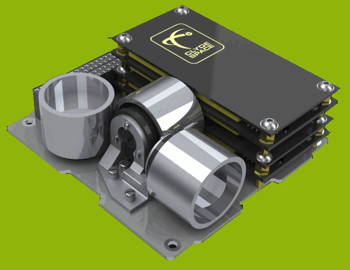
The satellite’s three-axis attitude control system (above) is based on torque reaction positioning system that uses a reaction/momentum flywheel driven by a brushless DC motor. By changing the speed of the flywheel, a reactionary torque is applied to rotate the CubeSat around an axis. Maintaining the rotation will stabilise the satellite.
Three of these reaction/momentum wheels are needed to provide full three-axis attitude control and stability. The motors being used to drive the reaction wheels are standard 20mm-diameter maxon motor brushless DC devices, which maxon has modified to withstand the arduous application environment. It also fitted the flywheels, and balanced the complete assemblies dynamically using a laser to remove material from the discs while they were spinning at 2,000 rpm.
“We have worked with maxon to ensure the brushless DC motors survive the high vibration and shock loads challenges seen on rocket launches, and the high thermal cycling and radiation levels experienced in orbit,” says Clyde Space’s CEO, Craig Clark.
“We are now able to offer our customers a full three-axis attitude control system based on off-the-shelf components,” he adds. “It is refreshing to see a customised off-the-shelf product meet this demanding environment, rather than use a bespoke-designed motor with the cost implications involved.”
Clyde Space is now working with maxon on improvements for future CubeSat attitude control systems, which could open up opportunities for further nano-satellite applications, such as earth observation with high-resolution cameras, or transmitting high bandwidth data. Other potential application areas include space science, astronomy and the verification of new technologies in orbit.

